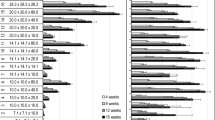Abstract
The role of test block placement within a modified decay jar system for promotion of fungal pigments was investigated. Beech and sugar maple blocks were inoculated with common pigment producing fungi and incubated for 10 weeks. Blocks were placed either below the vermiculite or resting on its surface; no feeder strips were utilized. Amount of pigmentation differed with block placement with Arthrographis cuboidea (on sugar maple and beech) and Xylaria polymorpha (only on sugar maple) producing more pigment when placed on the surface of the vermiculite. The differences in pigmentation, however, were not necessarily due to moisture content differences within test blocks, as moisture content did not vary significantly by block placement with A. cuboidea. Results indicate that placement of wood above vermiculite may increase pigmentation; however, reasons for the increase appear to differ among fungi.



Similar content being viewed by others
References
Ali NA, Jansen R, Pilgrim H, Liberra K, Lindequist U (1996) Hispolon, a yellow pigment from Inonotus hispidus. Phytochemistry 41(3):927–929
American Wood-Preservers Association Standard (2009) AWPA E10–09. Standard method of testing wood preservatives by laboratory soil-block cultures
Canessa EF, Morrell JJ (1995) Effect of mixtures of carbon disulfide and methylisothiocyanate on survival of wood-colonizing fungi. Wood Fiber Sci 27(3):207–224
Curling SF, Clausen CA, Winandy JE (2002) Experimental method to quantify progressive stages of decay of wood by basidiomycete fungi. Int Biodeterior Biodegrad 49:13–19
De Carvalho JC, Oishi BO, Pandey A, Soccol CR (2005) Biopigments from Monascus: Strains selection, citrinin production and color stability. Brazilian Archives of Biology and Technology 48:885–894
Donovan G, Nicholls D (2003) Consumer preferences and willingness to pay for character-marked cabinets from Alaska birch. Forest Prod J 53(11/12):27–32
Feeney N, Curran PMT (1992) Biodeterioration of woods by marine fungi and Chaetomium globosum in response to an external nitrogen source. Int Biodeterior Biodegrad 29:123–133
Golinski P, Krick TP, Blanchette RA, Mirocha CJ (1995) Chemical characterization of a red pigment (5, 8-dihydroxy-2, 7-dimethoxy-1, 4-naphthalenedione) produced by Arthrographis cuboidea in pink stained wood. Holzforschung 49:407–410
Hajjaj H, Blanc PJ, Groussac E, Goma G, Uribelarrea JL, Loubiere P (1999) Improvement of red pigment citrinin production ration as a function of environmental conditions by Monascus ruber. Biotechnol Bioeng 64:497–501
Kozak RA, Cohen DH, Lerner J, Bull GQ (2004) Western Canadian consumer attitudes towards certified value-added wood products: An exploratory assessment. Forest Prod J 54(9):21–24
Medentsev AG, Arinbasarova AY, Akimenko VK (2005) Biosynthesis of naphthoquinone pigments by fungi of the genus Fusarium. Applied Biochemistry and Microbiology 41:503–507
Morrell JJ, Zabel RA (1985) Wood strength and weight losses caused by soft rot fungi isolated from treated southern pine utility poles. Wood Fiber Sci 17(1):132–143
Robinson SC, Laks PE (2010a) Culture age and wood species affect zone line production of Xylaria polymorpha. Open Mycol J 4:18–21
Robinson SC, Laks PE (2010b) Wood species affects colonization rates of Chlorociboria sp. Int Biodeterior Biodegrad 64:305–308
Robinson SC, Richter DL, Laks PE (2007) Colonization of sugar maple by spalting fungi. Forest Prod J 57(4):24–32
Robinson SC, Laks PE, Turnquist EJ (2009a) A method for digital color analysis of spalted wood using Scion Image software. Materials 2(1):62–75
Robinson SC, Richter DL, Laks PE (2009b) Effects of substrate on laboratory spalting of sugar maple. Holzforschung 63:491–495
Robinson SC, Laks PE, Richter DL (2011) Stimulating spalting in sugar maple using sub-lethal doses of copper. Eur J Wood Prod 69(4):527–532
Schwarze FWMR, Lonsdale D, Fink S (1995) Soft rot and multiple T-branching by the basidiomycete Inonotus hispidus in ash and London plane. Mycol Res 99(7):813–820
Author information
Authors and Affiliations
Corresponding author
Rights and permissions
About this article
Cite this article
Robinson, S.C., Tudor, D. & Cooper, P.A. Promoting fungal pigment formation in wood by utilizing a modified decay jar method. Wood Sci Technol 46, 841–849 (2012). https://doi.org/10.1007/s00226-011-0453-8
Received:
Published:
Issue Date:
DOI: https://doi.org/10.1007/s00226-011-0453-8




